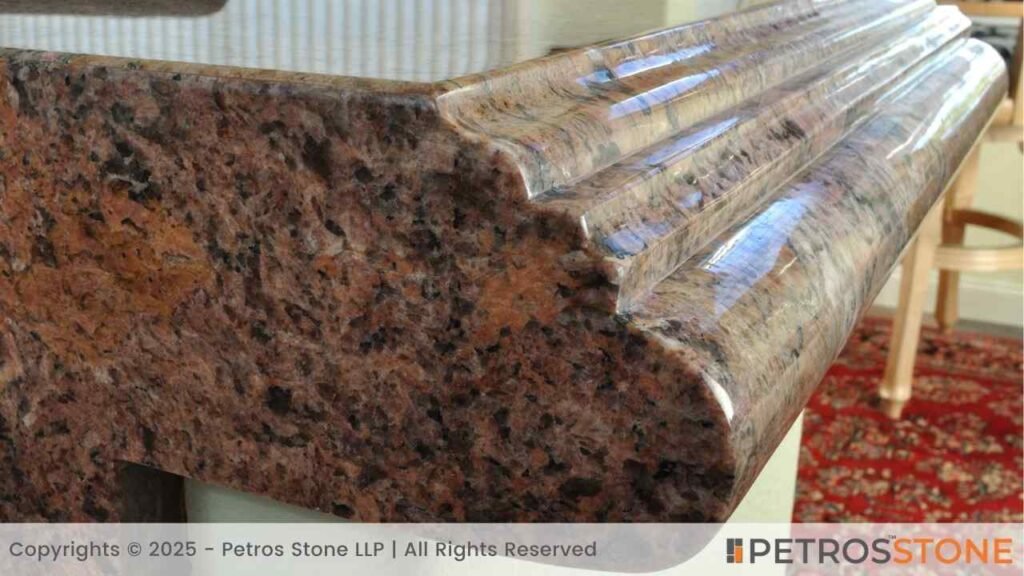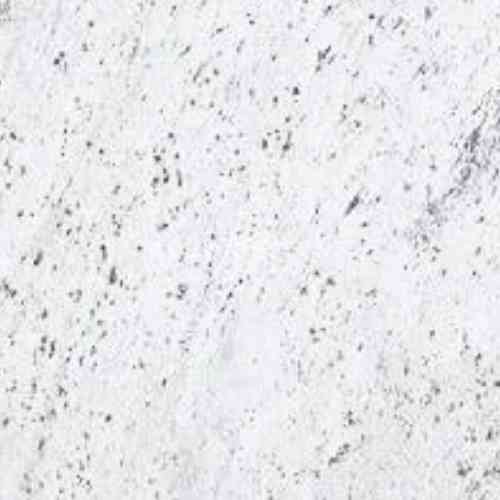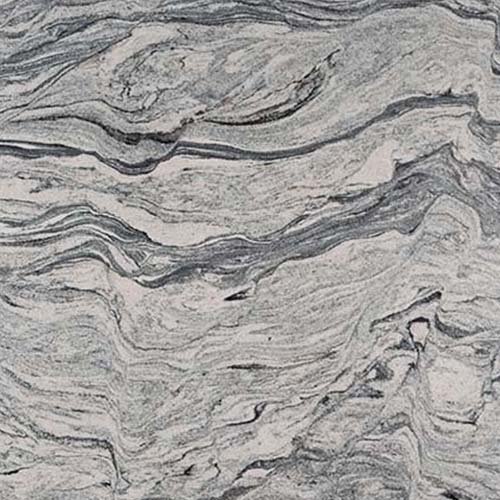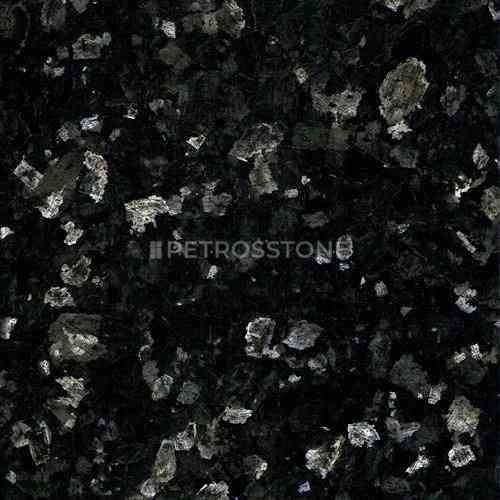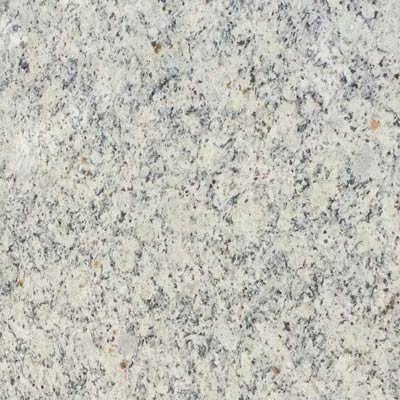
If you are picking out a coutnertop for your kitchen or bathroom, you have probably come across the term bullnose edge. But what does it really mean, and is it the right choice for you?
You will find many edge options available in the market, and among those the bullnose edge stands out as one of the most popular choices.
But, is it really the best edge profile for your countertop?
In this article, we will look closely at the bullnose countertop edge, its types, and why in some cases it may not be the best edge profile for you.
- Understand What is a Bullnose Granite Edge
- Types of Bullnose Edge
- Where is Bullnose Edge Used?
- How Does It Differ From Other Granite Edge Profiles?
- Is the Bullnose Edge Outdated?
- How Much Does a Bullnose Granite Edge Cost?
- Factors That Affect Pricing of the Bullnose Granite Edge
- Pros and Cons of Bullnose Granite Edge
- Final Thoughts: Is Bullnose Right for You?
- FAQs
Understand What is a Bullnose Granite Edge

Instead of having a sharp or flat edge, the bullnose is rounded. You will see that it is rounded, soft, curved, and polished.
This rounded edge gives countertops a clean, gentle look. It also helps prevent chipping and is safer, especially if you have got little ones running around.
Types of Bullnose Edge
Bullnose edges are super popular because they are smooth and safe, but did you know there are actually several different styles? Each one has its own look and feel, and some can even be customized with special shapes or angles to make your countertop truly one of a kind.
So, let’s know about some of the main types so you can picture what they look like:
1. Full Bullnose

This one is the classic bullnose edge you probably have noticed around you. It is completely rounded all the way around. From the top to the sides and underneath, the edge is soft and curved. Just because it is so smooth, you won’t hurt yourself if you bump into it. Plus, it is easy to glide your hands or objects along it without scratching anything. And, you must know it is a favorite choice for kitchens and bathrooms because it’s both pretty and practical.
2. Half Bullnose

As the name says, in these types of Bullnose granite edge only half of this edge is rounded. This means the top part is curved, but the bottom edge is straight. It still looks nice and soft on the surface, but it is a little less rounded underneath. Plus, it tends to be a bit cheaper than the full bullnose. And, it is a great option if you want some of the gentle feel of a bullnose edge but a slightly different style.
3. Demi Bullnose

The demi bullnose is a softer, more subtle version. It is rounded on the top but curves back a little more gently than the others. Think of it as a smooth, quiet curve rather than a bold round. It gives the countertop a nice, polished look without being too “in your face” with the shape.
4. Double Bullnose

This one looks really special — it is like two bullnose curves stacked together. Imagine a soft, flowing wave or water gently rolling over smooth stones. That’s the kind of elegant, flowing edge you get here. It’s a high-end style that not only looks amazing but also helps water slide off easily without messing up your cabinets below.
5. Cove Bullnose

The cove bullnose is a fancy upgrade that combines a deep curved edge (called a cove) with the soft roundness of a bullnose. It looks luxurious and works really well on big kitchen islands or spots where the countertop is a centerpiece. This edge has two curves that come together, making it pricier but definitely worth it for the wow factor.
6. Laminate Edge

When two different edges are joined together, that’s called a laminate edge. This one is super flexible because you can mix and match styles to create a unique look that’s all your own. For example, you could combine a bullnose with a straight edge or a bevel. Well, this customization usually costs a bit more but lets you get really creative with your countertop design.
Where is Bullnose Edge Used?

You will spot bullnose edges in a variety of places, and for good reason! Their smooth profile makes them incredibly versatile:
- Kitchens: From prep islands to perimeter counters, the bullnose is a kitchen favorite. It is practical and adds a timeless appeal.
- Bathrooms: Vanity tops often feature bullnose edges, contributing to a spa-like and serene atmosphere.
- Stairs: Yes, even on stair treads! The rounded edge provides a safer and more comfortable transition.
How Does It Differ From Other Granite Edge Profiles?

Other granite edges like beveled, ogee, or eased have sharper or more angular finishes. These can feel more modern or elegant, but they’re not as soft to the touch.
Bullnose edges, on the other hand, are:
- Round instead of angled
- Safer for children
- Less likely to chip
- Often seen as more traditional
Compared to a Straight/Eased Edge
A straight edge is just that – a clean, 90-degree angle with a very slight softening. Whereas the bullnose is all about the curve.
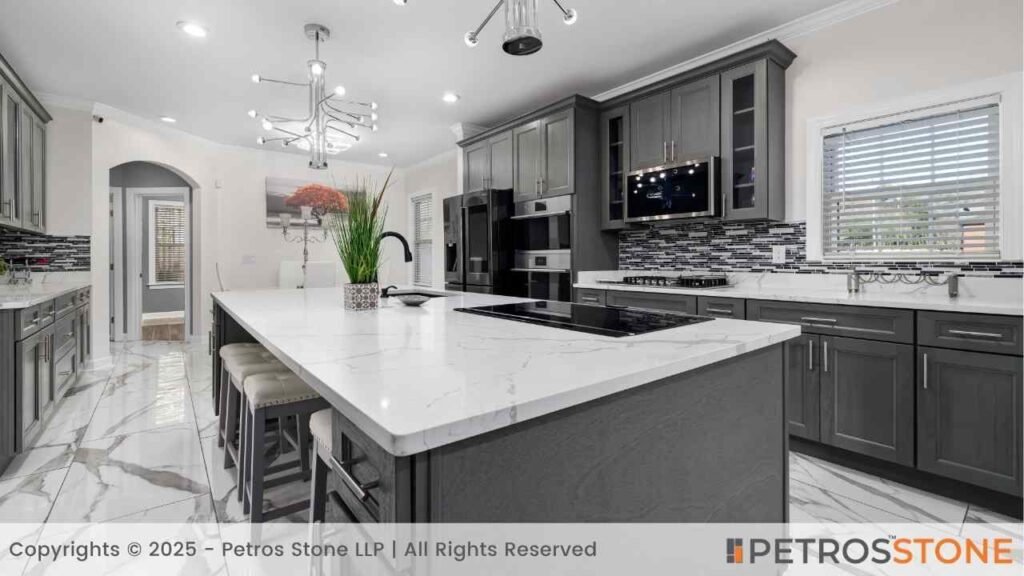
Compared to Beveled
A beveled edge has a cut-off corner at an angle which gives it a more defined, chiseled look. On the other hand, the bullnose is completely round and flowing.
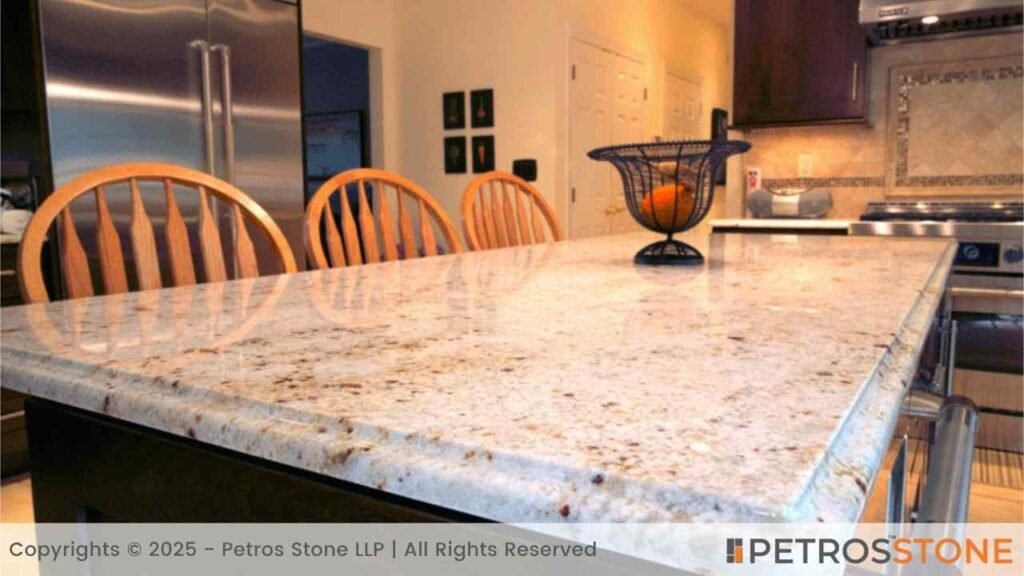
Compared to Ogee/Cove
These profiles are more decorative, featuring S-shapes or concave curves. And when it comes to the bullnose it is much simpler and more understated in its elegance.
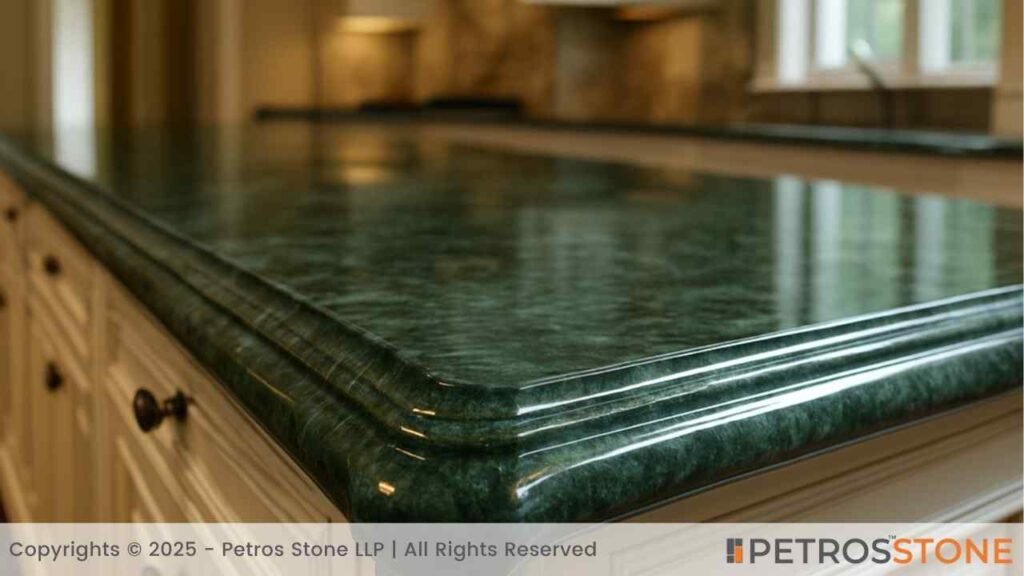
So, the main difference comes down to style preference and how you use the space.
Is the Bullnose Edge Outdated?
This is a question that pops up a lot! Some people think bullnose edges are “old-fashioned” because they’ve been around for a long time. But the truth is — they are classic.
Bullnose edges never really go out of style. They are still used in new homes, remodels, and even high-end kitchens. Whether it looks modern or traditional depends on your overall design, not just the edge.
Just pair it with sleek cabinets and modern lighting, and it fits right in.
How Much Does a Bullnose Granite Edge Cost?
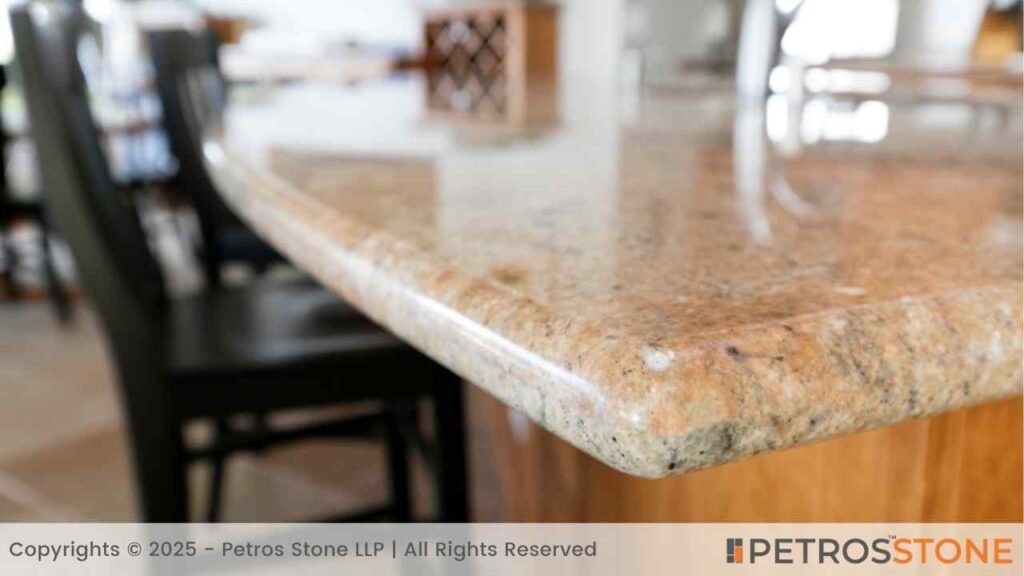
When it comes to pricing, there is no single magic number, but here’s a general idea:
You can expect to pay anywhere from $10–$30 per linear foot for a bullnose edge. Some fabricators might price it per slab as part of a package.
- Full Bullnose: $15 – $46
- Half Bullnose: $12 – $22
- Demi Bullnose: $10 – $12
- Double Bullnose: $36 – $40
- Cove Bullnose: $35 – $40
- Laminate Edge:(Full Bullnose): $7 – $10
Factors That Affect Pricing of the Bullnose Granite Edge
When picking a bullnose edge for your granite countertop, the price can change depending on a few things. Let’s see the main reasons how:
Custom vs. Standard
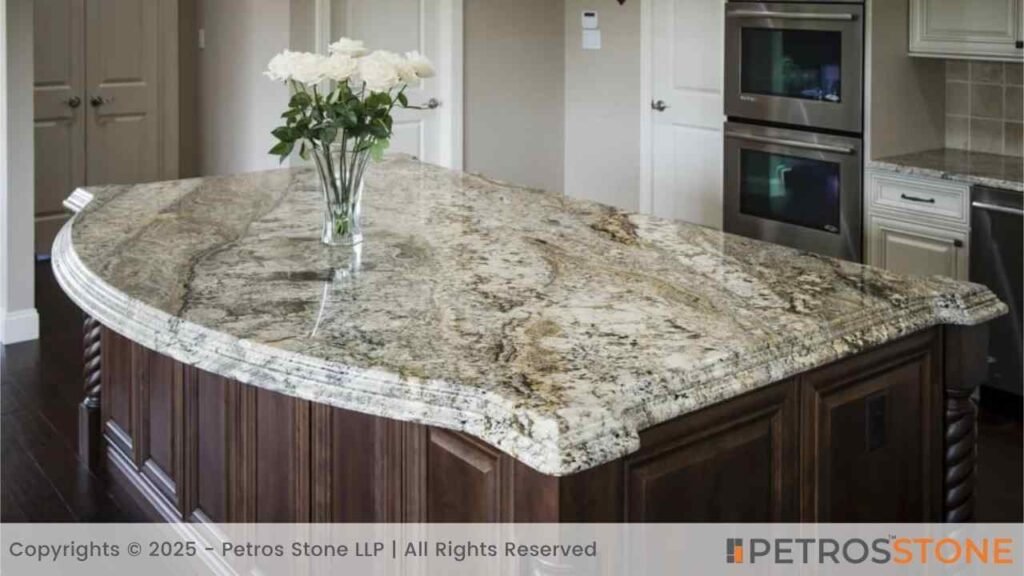
If you want something really unique or fancy — like a special shape or an intricate design — it usually costs more than a basic, standard bullnose edge like the full or half bullnose. You can think of it like ordering a custom cake versus buying one from the store: the more detailed and special you want it, the higher the price.
Single vs. Full Bullnose
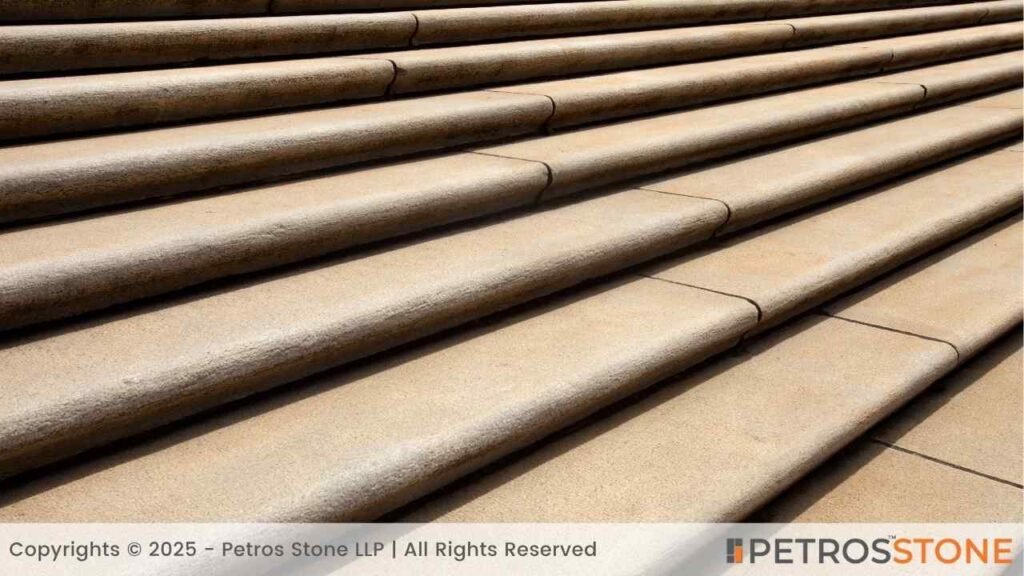
A half bullnose (which is rounded only on the top) often costs a little less than a full bullnose because it takes less time and work to make. Since the full bullnose is rounded all around, it needs more careful shaping, which means more labor and a bit higher cost.
Granite Type

So basically, if you pick a fancy, rare, or tough-to-work-with granite, expect to pay more for that smooth, rounded bullnose edge. But if you go with a more common and easier granite, it will probably be kinder to your budget.
Who Does the Work & Where You Live
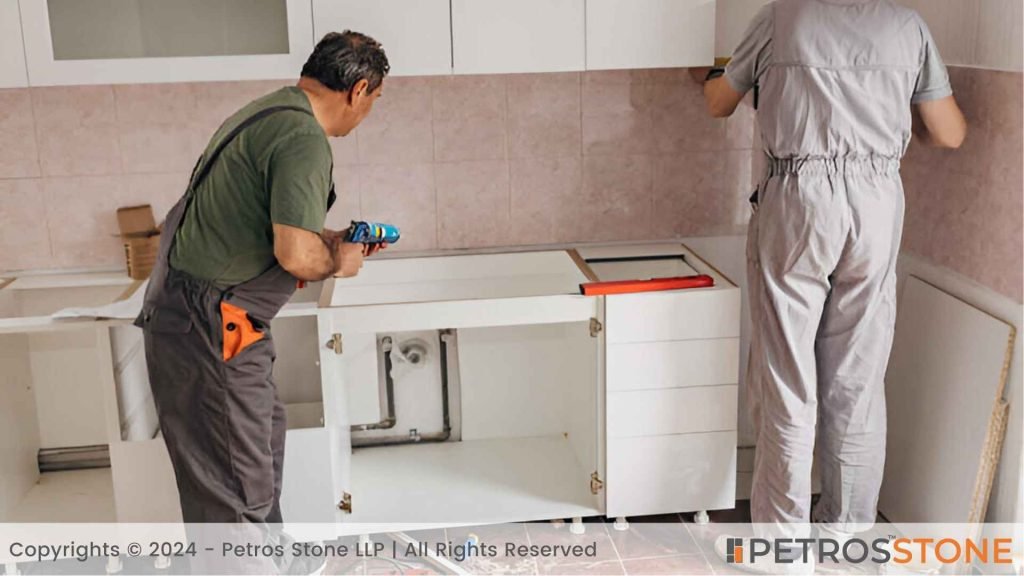
The price can also change depending on who is cutting and shaping your granite — some fabricators charge more based on their experience or reputation. Plus, where you live matters too! Some places have higher prices for materials and labor, so your countertop might cost a bit more or less depending on your location.
Pros and Cons of Bullnose Granite Edge
Every design choice has its ups and downs, and the bullnose is no exception:
Pros
- Soft, rounded look
- Safe and kid-friendly
- Easy to clean and maintain
Cons
- Water can drip more easily onto cabinets.
- It may look too traditional for modern interiors.
- Can slightly reduce the visual thickness of the countertop.
Final Thoughts: Is Bullnose Right for You?
Ultimately, choosing a bullnose granite edge comes down to your personal taste, lifestyle, and the overall vibe you want for your space. If you love a classic, comfortable, and safe aesthetic, and appreciate easy maintenance, then the bullnose could be your perfect match. But if you are leaning towards a super modern or edgy look, you might want to explore other options.
Read this article to find out different types of edge profiles and find the best for your countertop.
FAQs
Is Bullnose Better than a Beveled Edge?
It depends on your needs. Bullnose is smoother and safer, while beveled edges look sharper and more modern. For family homes or high-traffic areas, bullnose is often preferred.
Can I use Bullnose Edges with Quartz or Marble, too?
Yes! Bullnose edging works on many materials, not just granite. It looks just as good on quartz, marble, and other solid surfaces.
How do I Clean and Maintain a Bullnose Edge?
Simple! Just wipe it down with a soft cloth and mild soap. Because there are no corners, crumbs and spills don’t get trapped. That makes cleaning quick and easy.
Feel free to get in touch for a free consultation, quote, and get a detailed understanding from our experts here at Petros®. Visit https://petrosstone.com/ or call +91-8446360361 and WhatsApp
Brown Granite
White Galaxy Granite
Blue Bahia Granite
Silver Cloud Granite
Black Pearl Granite
Dallas White Granite





